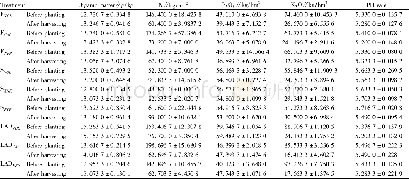《Table 8–Fate of15N-urea in the wheat and peanut cropping system during 2016–2017.》
 提示:宽带有限、当前游客访问压缩模式
提示:宽带有限、当前游客访问压缩模式
本系列图表出处文件名:随高清版一同展现
《Timing and splitting of nitrogen fertilizer supply to increase crop yield and efficiency of nitrogen utilization in a wheat–peanut relay intercropping system in China》
Sustainable crop production depends on the continuous renewal of soil fertility through a balance between N demand and supply in cropping systems.Nitrogen(N)is the most essential of all fertilizers for crop growth,productivity,and grain quality[36].Efficient nitrogen fertilizer management is essential for achieving economic yield and enhancing N use efficiency[37].In the present study,at the same N fertilizer rates,the peanut pod yield in N3(topdressing until G40)was higher by5.9%than that in N2(topdressing at G30)(Table 4) ;further,N3 did not reduce wheat yield(Table 3).As a result,N3 resulted in a higher total crop yield of wheat and peanut than N2.This finding is consistent with those of Li et al.[27],who found that delaying the topdressing fertilization time of wheat could boost crop productivity in the wheat–peanut relay intercropping system.Thus,the nutrients released under the N3 treatment met the requirements of the crops,in turn promoting the transport of dry matter from vegetative organs to grain and pod during yield formation and thereby increasing yield.
| 图表编号 | XD0029302600 严禁用于非法目的 |
|---|---|
| 绘制时间 | 2019.02.01 |
| 作者 | Zhaoxin Liu、Fang Gao、Yan Liu、Jianqun Yang、Xiaoyu Zhen、Xinxin Li、Ying Li、Jihao Zhao、Jinrong Li、Bichang Qian、Dongqing Yang、Xiangdong Li |
| 绘制单位 | State Key Laboratory of Crop Biology, Shandong Agricultural University、College of Agronomy, Shandong Agricultural University、State Key Laboratory of Crop Biology, Shandong Agricultural University、College of Agronomy, Shandong Agricultural University、State |
| 更多格式 | 高清、无水印(增值服务) |
查看“Table 8–Fate of15N-urea in the wheat and peanut cropping system during 2016–2017.”的人还看了
-

- Table 2.Ratios between observed and simulated crop yields under different ranges of the Standardized Precipitation Evapo
-

- Table 3 Soil nutrient reduction amounts in the early and late rice cropping fields and LAD (Mean±standard deviation) *
-

- Table 7 Effect of fertilization in the early and late rice cropping fields on the economic benefits of rice





